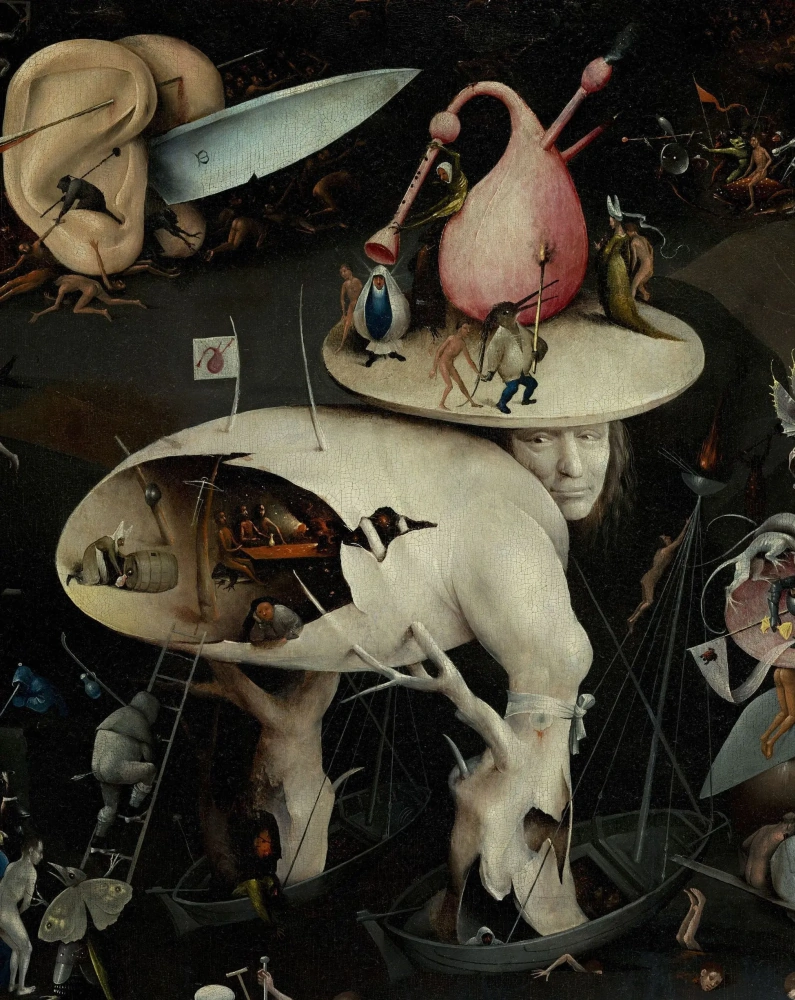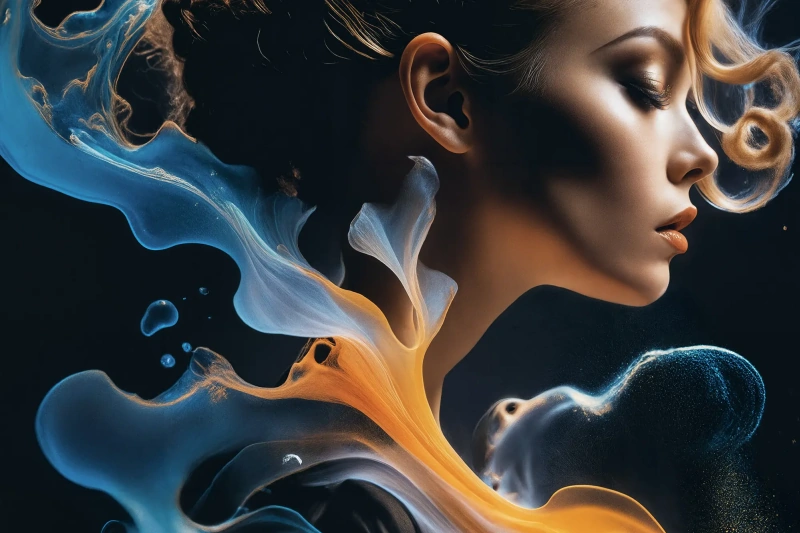Пожалуй, в истории живописи не случалось другого персонажа, чья личность вызывала бы столь живой интерес у широкой общественности и в то же время была бы окутана таким густым туманом. Доподлинно об Иерониме Босхе известно немного — историки не знают даже точной даты его рождения. А там, где недостает фактов, правят бал смелые гипотезы.

Сад земных наслаждений
1500-е
, 220×390 см
В определенном смысле биография Босха подобна его знаменитому триптиху «Сад земных наслаждений». В «закрытом» виде — это скудный монохромный перечень архивных документов. Но стоит искусствоведам приоткрыть створки воображения, и жизнь Босха расцветает самыми невероятными событиями, красками и образами.
В самом деле, кем был этот удивительный человек? Мессией, антихристом, провидцем, безумцем или, может быть, всем этим сразу? Вот самые популярные версии, будоражащие умы исследователей на протяжении нескольких веков.
В самом деле, кем был этот удивительный человек? Мессией, антихристом, провидцем, безумцем или, может быть, всем этим сразу? Вот самые популярные версии, будоражащие умы исследователей на протяжении нескольких веков.
Тайный еретик
О том, что работы Босха тронуты «тленом ереси» начали говорить еще в XVI веке, и сегодня эта гипотеза ничуть не утратила актуальности. В основном, ее сторонники делятся на два лагеря. Первые считают, что Босх состоял в секте адамитов — обществе Свободного Духа, члены которого совершали свои обряды нагишом, проповедовали свободу сексуальных отношений, не признавали частной собственности и рассчитывали построить на земле новый Эдем, где все были бы равны, невинны и беспечальны, словно Адам и Ева. В качестве «доказательства» некоторые исследователи приводят центральную часть триптиха «Сад земных наслаждений», считая, что Босх изобразил ритуалы «клуба, за который играет» (в частности эту гипотезу активно лоббировал немецкий историк искусства Вильгельм Френгер).Другие уверены, что изобильная обнаженная натура нужна художнику, чтобы показать свое презрение к плотским утехам. К примеру, биограф Линда Харрис считает, что ересь Босха восходит к катаро-манихейской традиции с ее четким дуализмом (отсюда очевидное «деление» образов на Свет и Тьму, рай и ад, духовное и материальное).
И те, и другие упорно игнорируют тот факт, что во времена Босха инквизиция свирепствовала с особым тщанием. И пробежаться нагишом по улицам Хертогенбоса, проповедуя свободную любовь или двойственность мироздания (пусть даже в живописной иносказательной манере) можно было разве что до ближайшей дыбы.
Ревностный католик
В то время как часть биографов выясняет отношения, споря, к какой именно ереси тяготел Босх, другие уверены, что он был истово верующим католиком, как сказали бы в наше время — «тру». И антиклерикальный пафос, который бесспорно присутствует в его работах, вызван как раз мягкостью Престола по отношению к адамитам, манихейцам, гуманистам и прочим греховодникам.Босх жил в эпоху великого перелома. Сквознячки гедонизма, гулявшие по Италии, задували в Северную Европу. Бедность, смирение, умеренность — идеалы, казавшиеся незыблемыми веками, вдруг дрогнули под натиском крамольной идеи о том, что «человек — венец творений природы». Церковь теряла былой авторитет, и Босх остро чувствовал, что час расплаты не за горами. Вездесущих жаб и сов, ассоциировавшихся с тьмой и ересью, он рисовал в назидание. Священников изображал деградантами, поскольку считал, что церковь тоже погрязла в алчности и разврате. И дивные образы того же «Сада земных наслаждений» навеяли ему не еретические учения, а незамутненное чувство католической вины.
В пользу этой теории говорит и то, что после смерти Босх со всеми почестями был отпет в соборе св. Иоанна. И то, что его работа «Семь смертных грехов» висела в покоях короля Испании Филиппа II — монарха, преследовавшего еретиков с особой яростью.
Практикующий алхимик
Центральную часть триптиха «Сад земных наслаждений» нередко называют «алхимическим садом»: тут и изобильная астрологическая символика, и совокупления в стеклянных сферах (читай колбах и ретортах), и непременный «Фонтан юности» — собственно алхимический контекст ни у кого не вызывает сомнений. Что касается отношения Босха к алхимии — его трактуют по-разному.К примеру, французский исследователь Жак Шайи называет Босха «пристрастным свидетелем одного из важных этапов алхимического искусства». Притом Шайи настаивает на том, что Босх был непримиримым врагом алхимии, считал ее ересью и объектом сатиры. Другие полагают, что Босх не только был «пристрастным свидетелем», но и практиковал сам. Это правдоподобная версия — многие художники пытаются добыть золото посредством химических реакций между холстом и красками (магическим эликсиром тут иногда выступает талант, а иногда — ушлый арт-дилер). Впрочем, это явно не про Босха: Иероним удачно женился на богатой и работал не ради денег.
Визионер
Многие уверены, что патологическая образность Босха — родом из видений, которые посещали художника в состоянии измененного сознания. Однако насчет природы видений единодушия снова нет.Кто-то норовит поставить Босху диагноз. Так видный российский психиатр Марк Бурно отмечает, что творчеству Босха свойственен «полифонический характер — своеобразная характерологическая мозаика , порожденная шизофреническим процессом».
Немногочисленные биографические факты свидетельствуют о том, что Босх прожил удручающе нормальную и даже скучную жизнь. Кроме того, современная психиатрия считает, что в той или иной мере шизотипическим расстройством личности страдает каждый десятый, а в мире искусства — и вовсе каждый третий. Так что, если эта версия и состоятельна, то разве что в качестве утешения тем мастерам культуры, которых природа обделила воображением.
Другие намекают на то, что для «погружения в тему» Босх принимал рекреационные препараты. Сегодня сложно поверить, что у голландского художника могли возникнуть с этим какие-либо сложности. Однако во времена Босха кофешопов было не так уж много. И никаких документальных свидетельств о том, что в XV веке в Хертогенбосе проводились транс-вечеринки и психоделические оупен-эйры до нас не дошло. В общем, культура потребления галлюциногенов в те годы была не на высоте.
Существует также третья версия — о том, что Иероним Босх продал душу Дьяволу в обмен на возможность путешествовать в другие миры. Впрочем, она почему-то недостаточно активно дискутируется научным сообществом.
Инопланетянин
Исследуя выполненную Босхом роспись одного из соборов Хертогенбоса, голландский профессор иконографии Эдмунд ван Хооссе пришел к выводу, что Иероним был свидетелем прибытия НЛО. А вот американский уфолог Джордан Хардс считает версию ван Хооссе недостаточно обоснованной. По его мнению, Босх, наблюдавший пришельцев в XV веке, — это антинаучный вздор: совершенно очевидно, что Босх сам был пришельцем. Забудьте о метафорах и аллегориях — Босх был реалистом. Летающие рыбы? Ученая саранча? Меланхоличное древесное чудище, в чреве которого пирует веселая компания? Там, откуда он родом, все это обычное дело.Исполнитель капризов заказчиков
И, наконец, гипотеза, которая кажется вполне достоверной: Босх любил загадывать зрителю загадки, его самого забавляло обилие трактовок и смыслов, которые вкладывала в его работы публика. Он был внимателен к желаниям заказчика и добросовестно исполнял его капризы (особенно, если заказчик был влиятельным вельможей). Не забывая притом оставить интригу — чтобы, разгадывая ребус, влиятельный вельможа мог остаться в дураках.Иконографическое решение «Сада земных наслаждений» было отчасти продиктовано религиозным содержанием, но также было рассчитано и на мощный визуальный эффект. Легко представить, какое впечатление производил на гостей владевший картиной Генрих III, когда распахивал внешние черно-белые створки. Босх был «полиглотом», универсальным переводчиком на любой язык. Он зашифровывал в своих образах библейские сюжеты, сатирические намеки и — в изобилии — местный фольклор тех лет. Так фрагмент центральной части с любовниками в стеклянной сфере, мог символизировать грехопадение, мог показаться пропагандой учения адамитов или его критикой, мог быть прочитан как алхимическая аллегория , а мог быть и просто иллюстрацией к старой нидерландской поговорке: «Стекло и любовь — как они недолговечны!».
Да что сфера, изображение обычной рыбы могло означать Христа, знак зодиака, Луну, месяц февраль, воду, флегматический темперамент, быть атрибутом любострастия, служить символом поста, а также намекать на голландские пословицы: «Большая рыба поедает маленькую» или «Каждая селедка на своем хвосте висит».
И это не считая тех случаев, когда рыба означала рыбу.
Также мы приготовили для вас два увлекательных теста по творчеству Иеронима Босха:
1. «Босх в деталях»: угадайте, из каких картин Босха взяты фрагменты с демонами и святыми.
2. «Босх или не Босх?»: в каждой паре картин только одна принадлежит Босху — выбор за вами.
1. «Босх в деталях»: угадайте, из каких картин Босха взяты фрагменты с демонами и святыми.
2. «Босх или не Босх?»: в каждой паре картин только одна принадлежит Босху — выбор за вами.
Заглавная иллюстрация: Сад земных наслаждений. Сотворение Мира. Внешние створки
Автор: Андрей Зимоглядов
Автор: Андрей Зимоглядов
Рекомендуем почитать
5 мин.Письма нежному другу: чувственные послания юного Люсьена Фрейда писателю Стивену Спендеру уйдут с молотка4 мин.Впервые за 30 лет в Мадриде представили архетипы Эдварда Мунка3 мин.Картина за миллион: Эрмитаж получил "Аврору" Ансельма Кифера5 мин.Напавший на Марину Абрамович мужчина утверждает, что это был акт искусства
4 мин.Реставрация знаменитой картины Вермеера завершилась. Она никогда не будет прежней10 мин.В Венеции выставили отреставрированные работы Босха – единственные в Италии16 мин.Босх его знает: главные символы «Сада земных наслаждений» крупным планом19 мин.Интервью с художником Алексеем Смоловиком. Журнал "Вода живая" 12(декабрь)2024























